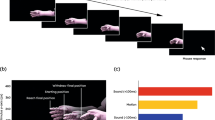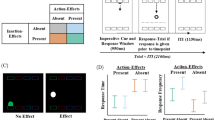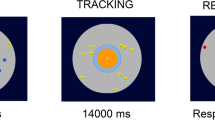Abstract
Behavior is typically organized in terms of a goal one intends to achieve rather than in terms of the anatomical components used in doing so. Similarly, perceptual behavior is typically organized in terms of a property one intends to perceive rather than in terms of the anatomical components used in doing so. Such task-specificity and anatomical independence are manifest in perception of properties of wielded objects. We investigated whether these properties are also manifest in perception of properties by means of wielded objects. Blindfolded participants explored an inclined surface with a rod attached to their preferred or non-preferred foot and reported whether they would be able to stand on that surface. Perception reflected action capabilities, but was unaffected by foot used, highlighting the haptic system as a smart perceptual device.


Similar content being viewed by others
Notes
Previous research (Burton 2000) has shown that hearing the contact between a hand-held dowel and the support surface is neither necessary nor sufficient for perceiving affordances of that surface.
Power analyses were conducted for these nonsignificant tests using the G*Power program (Faul et al. 2007). Effect sizes were estimated using significant main effects or interactions reported by Wagman and Hajnal (in preparation). As in the current experiment, these authors investigated perception of affordances for standing on an inclined surface when that surface is explored with a rod wielded by different (configurations of) anatomical components and used the same set of dependent measures. For all tests, Cohen’s f was estimated to be between .37 and .58 (a “large” effect size, see Keppel and Wickens 2004). Using this effect size, G*Power estimated power for the nonsignificant tests reported here to be between .92 and .99.
References
Ball KA (2011) Kinematic comparison of the preferred and non-preferred foot punt kick. J Sports Sci 29:1545–1552. doi:10.1080/02640414.2011.605163
Bingham GP (1988) Task-specific devices and the perceptual bottleneck. Hum Mov Sci 7:225–264. doi:10.1016/0167-9457(88)90013-9
Burton G (1993) Non-neural extensions of haptic sensitivity. Ecol Psychol 5:105–124. doi:10.1207/s15326969eco0502_1
Burton G (2000) The role of the sound of tapping for nonvisual judgment of gap crossability. J Exp Psychol Hum Percept Perform 26:719–900. doi:10.1037//0096-1523.26.3.900
Carello C, Fitzpatrick P, Domaniewicz I, Chan TC, Turvey MT (1992) Effortful touch with minimal movement. J Exp Psychol Hum Percept Perform 18:290–302. doi:10.1037/0096-1523.18.1.290
Carello C, Thuot S, Andersen KL, Turvey MT (1999) Perceiving the sweet spot. Perception 28:1128–1141. doi:10.1068/p2716
Carello C, Thuot S, Turvey MT (2000) Aging and perception of a racket’s sweet spot. Hum Mov Sci 19:1–20. doi:10.1016/S0167-9457(99)00044-5
Carello C, Kinsella-Shaw J, Amazeen E, Turvey MT (2006) Peripheral neuropathy and object length perception by effortful (dynamic) touch: a case study. Neurosci Lett 405:159–163. doi:10.1016/j.neulet.2006.06.047
Chemero A (2003) An outline of a theory of affordances. Ecol Psychol 15:181–195. doi:10.1207/S15326969ECO1502_5
Coren S (1993) The lateral preference inventory for measurement of handedness, footedness, eyedness, and earedness: norms for young adults. Bull Psychon Soc 31:1–3. doi:10.3758/BF03334122
Faul F, Erdfelder E, Lang A-G, Buchner A (2007) G*Power 3: a flexible statistical power analysis program for the social, behavioral, and biomedical sciences. Behav Res Methods 39:175–191. doi:10.3758/BF03193146
Finney DA (1971) Probit analysis, 3rd edn. Cambridge University Press, London
Fitzpatrick P, Carello C, Schmidt RC, Corey D (1994) Haptic and visual perception of an affordance for upright posture. Ecol Psychol 6:265–287. doi:10.1207/s15326969eco0604_2
Gabbard C, Hart S (1996) A question of foot dominance. J Gen Psychol 123:289–296. doi:10.1080/00221309.1996.9921281
Gabbard C, Hart S (2000) Examining the notion of foot dominance. In: Mandal MK, Bulman-Fleming M, Tiwari G (eds) Side bias: a neuropsychological perspective. Springer, Netherlands, pp 249–257
Gibson JJ (1966) The senses considered as perceptual systems. Houghton Mifflin, Boston
Gibson JJ (1979) The ecological approach to visual perception. Houghton Mifflin, Boston
Gibson EJ (1994) Has psychology a future? Psychol Sci 5:69–76. doi:10.1111/j.1467-9280.1994.tb00633.x
Guiard Y (1987) Asymmetric division of labor in human skilled bimanual action: the kinematic chain as a model. J Mot Behav 19:486–517. doi:10.1080/00222895.1987.10735426
Hajnal A, Fonseca S, Harrison S, Kinsella-Shaw J, Carello C (2007a) Comparison of dynamic (effortful) touch by hand and foot. J Mot Behav 39:82–88. doi:10.3200/JMBR.39.2.82-88
Hajnal A, Fonseca S, Kinsella-Shaw J, Da Silva P, Carello C, Turvey MT (2007b) Haptic selective attention by foot and by hand. Neurosci Lett 419:5–9. doi:10.1016/j.neulet.2007.03.042
Hajnal A, Abdul-Malak DT, Durgin FH (2011) The perceptual experience of slope by foot and by finger. J Exp Psychol Hum Percept Perform 37:709–719. doi:10.1037/a0019950
Keppel G, Wickens TD (2004) Design and analysis: a researcher’s handbook. Prentice Hall, Englewood Cliffs
Kinsella-Shaw JM, Shaw B, Turvey MT (1992) Perceiving ‘walk-on-able’ slopes. Ecol Psychol 4:223–239
Kugler PN, Turvey MT (1987) Information, natural law, and the self assembly of rhythmic movements. Erlbaum, Hillsdale
Malek EA, Wagman JB (2008) Kinetic potential influences visual and remote haptic perception of affordances for standing on an inclined surface. Q J Exp Psychol 61:1813–1826. doi:10.1080/17470210701712978
Pagano C, Fitzpatrick P, Turvey MT (1993) Tensorial basis to the constancy of perceived object extent over variations of dynamic touch. Percept Psychophys 54:43–45. doi:10.3758/BF03206936
Pagano C, Kinsella-Shaw J, Cassidy P, Turvey MT (1994) Role of the inertia tensor in perceiving where an object is grasped. J Exp Psychol Hum Percept Perform 20:276–285. doi:10.1037/0096-1523.20.2.276
Palatinus Z, Carello C, Turvey MT (2011) Principles of part-whole selective perception extend to the torso. J Mot Behav 43:87–93. doi:10.1080/00222895.2010.538767
Peters M (1988) Footedness: asymmetries in foot preference and skill and neuropsychological assessment of foot movement. Psychol Bull 103:179–192. doi:10.1037/0033-2909.103.2.179
Proffitt DR (2009) Affordances matter in geographical slant perception. Psychon Bull Rev 16:970–972. doi:10.3758/PBR.16.5.970
Reed ES (1982) An outline of a theory of action systems. J Mot Behav 13:98–134. doi:10.1080/00222895.1982.10735267
Regia-Corte R, Wagman JB (2008) Perception of affordances for standing on an inclined surface depends on height of center of mass. Exp Brain Res 191:25–35
Runeson S (1977) On the possibility of “smart” perceptual mechanisms. Scand J Psychol 18:172–179. doi:10.1111/j.1467-9450.1977.tb00274.x
Stephen DG, Hajnal A (2011) Transfer of calibration between hand and foot: functional equivalence and fractal fluctuations. Atten Percept Psychophys 73:1302–1328. doi:10.3758/s13414-011-0142-6
Turvey MT (1992) Affordances and prospective control: an outline of the ontology. Ecol Psychol 4:173–187. doi:10.1207/s15326969eco0403_3
Turvey MT (2007) Action and perception at the level of synergies. Hum Mov Sci 26:657–697. doi:10.1016/j.humov.2007.04.002
Turvey MT, Carello C (2011) Obtaining information by dynamic (effortful) touching. Philos Trans R Soc Lond B Biol Sci 366:3123–3132. doi:10.1098/rstb.2011.0159
Turvey MT, Fonseca ST (2014) The medium of haptic perception: a tensegrity hypothesis. J Mot Behav 46:143–187
Wagman JB (2011) Just roll with it: Hearing properties of an inclined surface by means of a toy car. Paper presented at Illinoisy Data, Carbondale, IL
Wagman JB, Abney DH (2012) Transfer of recalibration from audition to touch: modality independence as a special case of anatomical independence. J Exp Psychol Hum Percept Perform 38:589–602. doi:10.1037/a0025427
Wagman JB, Day BM (2014) Changes in context and perception of maximum reaching height. Perception 43:129–144. doi:10.1068/p7620
Wagman JB, Hajnal A (2013) Perception of stand-on-ability by means of a wielded object exhibits anatomical independence. Paper presented at the seventeenth international conference on perception and action, Estoril, Portugal
Wagman J, Malek EA (2008) Perception of affordances for walking under a barrier from proximal and distal points of observation. Ecol Psychol 20:65–83. doi:10.1080/10407410701766650
Wang Z, Newell KM (2013) Footedness exploited as a function of postural task asymmetry. Laterality 18:303–318. doi:10.1080/1357650X.2012.672423
Witt JK, Proffitt DR (2007) Perceived slant: a dissociation between perception and action. Perception 36:249–257. doi:10.1068/p5449
Acknowledgments
We thank Dan Jackson for help with data collection, Brian Day for serving as the model in the figure, and Dawn McBride for help with data analysis. We also thank two anonymous reviewers for their helpful comments on a previous draft of this manuscript. Portions of the data were presented at the Seventeenth International Conference on Perception and Action (July 2013, Estoril, Portugal) and the 53rd Meeting the Psychonomic Society (November 2013, Toronto, Canada).
Author information
Authors and Affiliations
Corresponding author
Rights and permissions
About this article
Cite this article
Wagman, J.B., Hajnal, A. Getting off on the right (or left) foot: perceiving by means of a rod attached to the preferred or non-preferred foot. Exp Brain Res 232, 3591–3599 (2014). https://doi.org/10.1007/s00221-014-4047-1
Received:
Accepted:
Published:
Issue Date:
DOI: https://doi.org/10.1007/s00221-014-4047-1




